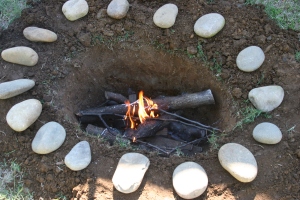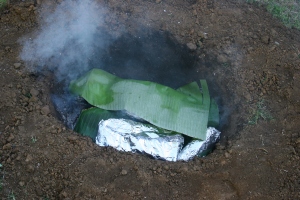 This posting was created on October 16 2010, World Food Day in celebration of that event. Due to the nature of this challenge (it took all day) I am posting the results today, October 17th. I will be adding a short video made during the process as soon as it is finished. Enjoy!
This posting was created on October 16 2010, World Food Day in celebration of that event. Due to the nature of this challenge (it took all day) I am posting the results today, October 17th. I will be adding a short video made during the process as soon as it is finished. Enjoy!
Hello Foodies! Happy World Food Day 2010 to you all. I am very happy to be able to present the national dish of Fiji today in honor of World Food Day, but I want to take a moment to reflect on the word hungry. Hungry is of course one part of the name of this blog, but it is also the daily state for so many human beings globally. I am curious why, if we are able to produce enough basic food to feed the whole planet, do so many people go to bed hungry every night? The answer of course is multifaceted and worth pondering. I feel like any little thing we can do to help promote the sustainable development of food stocks for the planet, especially encouraging local, high value agricultural projects (teach a person to farm) can overcome the issues facing our poorest places globally.
The group Feed the Children asked me to consider posting a neat interactive quiz they have designed for this days events. I agreed to post the quiz, but the code would not incorporate properly with a wordpress blog, so I am simply going to post the link to the Feed The Children website and the quiz itself. Try to guess the answers to the questions while learning some shocking facts about world hunger and food production/consumption and the numbers of children who are without the basic food necessary for survival. It is sobering to realize how good we have things compared to so many others…
www.savethechildren.org/worldfoodday
 On that note, we are going to visit an area of the globe we have barely touched on today. I am truly fascinated by the geography culture and food habits of this region. It is such a vast and underinhabited region that it cannot possibly have the amount of time in this blog as other more populated areas such as say, Africa with its numerous nations.
On that note, we are going to visit an area of the globe we have barely touched on today. I am truly fascinated by the geography culture and food habits of this region. It is such a vast and underinhabited region that it cannot possibly have the amount of time in this blog as other more populated areas such as say, Africa with its numerous nations.
That being said, I don’t know that many people who wouldn’t want to be on the beach in Fiji right now getting ready to eat a traditional feast (Lovo) with the locals, smelling the slow roasting essence of BBQ cooked underground. My tummy just rumbled typing that.
Fiji is an island nation in Melanesia about 2000 miles from New Zealand. Nearby islands include Vanuatu, Tonga, the Samoas and Tuvalu. The largest Island is Viti Levu. The following excerpt describes how the Islands got their current name and discusses English Colonization that continued in Fiji from the 18th century till 1970:
Fijians first impressed themselves on European consciousness through the writings of the members of the expeditions of Cook who met them in Tonga. They were described as formidable warriors and ferocious cannibals, builders of the finest vessels in the Pacific, but not great sailors. They inspired awe amongst the Tongans, and all their manufactures, especially bark cloth and clubs, were highly esteemed and much in demand. They called their home Viti, but the Tongans called it Fisi, and it was by this foreign pronunciation, Fiji, first promulgated by Captain James Cook, that these islands are now known.
 Although the word Fiji may inspire immediate thoughts of tropical paradise embodied and undisturbed tranquility, the political climate of Fiji has been anything but tranquil in recent times. In fact, Fiji has been the site of uprisings, military coups and charges of political brutishness by the self appointed leader. Since independence there have been four coups in Fiji, two in 1987, one in 2000 and one in late 2006. The military has been either ruling directly, or heavily influencing governments since 1987.
Although the word Fiji may inspire immediate thoughts of tropical paradise embodied and undisturbed tranquility, the political climate of Fiji has been anything but tranquil in recent times. In fact, Fiji has been the site of uprisings, military coups and charges of political brutishness by the self appointed leader. Since independence there have been four coups in Fiji, two in 1987, one in 2000 and one in late 2006. The military has been either ruling directly, or heavily influencing governments since 1987.
Culturally, Fiji is a blend of regional island cultures and imported ethnicities. The majority of the poulation is of ethnic Fijian heritage. The British brought Indo-Malaysian contract laborers to the Islands during occupation that now account for about 38% of the population. Small percentages of Solomon Islanders brought to Fiji as indentured servants account for a small but strong minority group. This combination of cultures has brought a unique blend of culture to Fiji making it a very interesting destination from a culinary standpoint.
Today’s recipe is more of a menu than a recipe. It combines several of the elements of Fijian cuisine in a unique cooking style that characterizes the beach BBQ probably better than any other culture. This method is oft repeated in other places but qualifies as the National Dish of Fiji for the sake of this challenge and is firmly rooted in the history and culture if this beautiful and troubled place. Lovo literally means Lava and is an underground oven using heated rocks to bake the food. It is as Fijian as it gets, and also the largest cooking challenge from a technical standpoint that we have undertaken to date. I will be photographing the steps of this recipe and I hope that some of you are inspired to build your own Lovo some day…
The Menu:
Fish – Whole Red Snapper rubbed in spices and wrapped in banana leaves
Chicken – Marinated in coconut milk, ginger, spicy chilies and lime
Curried Pork Short Ribs
Root Vegetables baked in foil
My version of Yaquona (Cava Root) beverage – In this case, Rum and Coconut Juice
Tropical fruit salsa
Rating:
Appearance: 3 out of 5
Aroma: 5 out of 5
Flavor: 5 out of 5
Total: 13 out of 15
Ingredients:
This entire meal is subjective. It can be made with chicken, pork or seafood and various root vegetables. Recipes can be altered and adjusted for each item to achieve the flavors you are interested in. Using authentic local ingredients will give you the most authentic result, but as with all global recipes, some adjustments may be made based on your local supply of ingredients. Try finding an Indian or Hispanic grocery for many of these items such as banana leaves. Also you can substitute foil if you cannot find banana leaves.
1 whole 3-4# fish scaled and gutted with slices across the sides
1 whole chicken
Salt
Pepper
Ginger Root
Chilies
Coconut Milk 2 cans
Limes
Root Vegetables (traditionally dalo (the potatolike root of the taro plant), cassava (the root of the tapioca plant) and Uvi (wild yam).
We will use: Yam
Pineapple
Mango
Tomatoes
Onions
Fresh Coriander/ Cilantro
Plantain Leaves about 10#
Round Dry River Rocks (be very careful as most rocks will explode if heated)
A round hole in the ground about 2 ft deep by 2.5 feet in diameter

Firewood
Tin Foil
Directions:
Dig a large hole in the ground, about 2.5 feet in diameter by 2 feet deep. Start a fire in the bottom of the hole and add the rocks to the top of the fire when it has burned for awhile. Be careful while the rocks are heating as they can explode causing severe injury!!!

Wrap all of the food items in either Banana leaves or some similar wrap and laythem carefully on layers of banana leaves over the hot rocks. Start with the meats and build up with the root vegetables on the top layers.


Cover the entire hole with more banana leaves and dirt and allow the food to cook for at least 3 hours.
Unearth the pit carefully with a shovel.

Carefully remove the wrapped food items with tongs and place on banana leaves to cool.
Open and serve!


Eric Ackerson is a food writer, blogger and seafood marketing professional. His work takes him to many ports of call around the world. Currently Eric is cooking the national dish of every country on Earth at his blog My Hungry Tum. Eric enjoys travel and says his favorite food cities are Singapore and Vancouver. He lives in Charlotte NC with his wife and two daughters who he says are quickly becoming “foodies” themselves…








